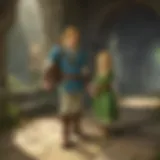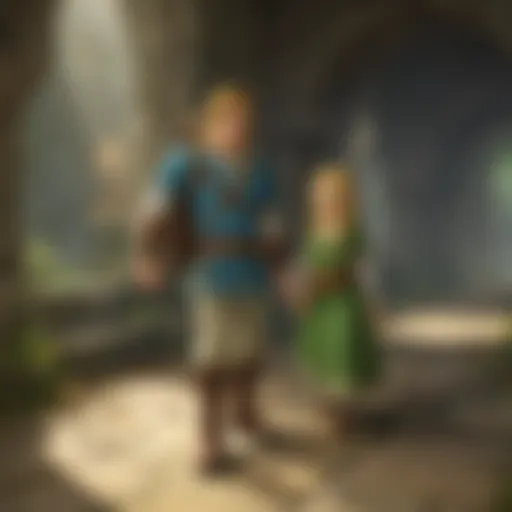Exploring The Depths of Zelda: Ocarina of Time
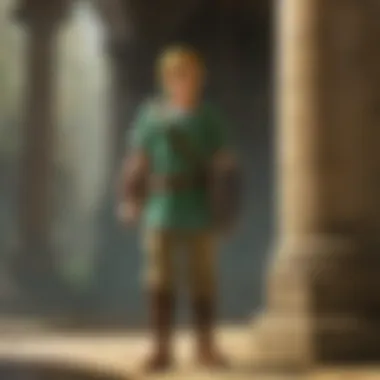

Intro
The realm of video gaming has seen a plethora of titles rise and fall, but few stand the test of time like The Legend of Zelda: Ocarina of Time. Released for the Nintendo 64 in 1998, it ushered in a new era for action-adventure games, leaving an indelible mark on both players and developers alike. Ocarina of Time's innovative mechanics and intricate storytelling not only captivated players but also set a benchmark for future games. By bridging the gap between engaging gameplay and remarkable world-building, it has become a timeless classic, a treasure trove packed with rich narratives and captivating explorations that are still relevant in today’s gaming landscape.
This article embarks on a comprehensive journey through the scenic landscapes of Hyrule. We will unpack the various layers that make this game a cornerstone of its genre. From gameplay features to character arcs, the influence of its sound and visuals, and the lore that breathes life into each quest, we will delve deeply into all the aspects that contribute to its legacy. We'll also share strategies for combat, puzzles, and collectible quests, all aimed at enhancing the experience for both newcomers and seasoned veterans.
So grab your ocarina, steady your sword, and join us in this exploration of a game that continues to resonate with gamers decades after its launch.
Historical Context of Ocarina of Time
Understanding the historical context of The Legend of Zelda: Ocarina of Time is pivotal to grasping not just the game itself, but also its monumental place in the gaming world. Released in 1998 for the Nintendo 64, it emerged during a critical time of evolution in video gaming. The late nineties were characterized by significant technological advancements, shifting gameplay paradigms, and an increasingly diverse gaming audience. This backdrop didn't merely set the stage for the game's innovative features; it also influenced the narrative, mechanics, and overall design philosophy that Nintendo embraced.
The Gaming Landscape in the Nineties
The nineties witnessed a seismic shift in the gaming industry, evolving from the pixelated graphics and simple gameplay of the eighties into a domain where narratives and immersive experiences became paramount. Games weren’t just about high scores anymore; they were stories waiting to be experienced. In this era, consoles like Sega Genesis and Super Nintendo achieved immense popularity, laying the groundwork for more complex storytelling. However, it was the 3D capabilities of the Nintendo 64 that truly changed the game.
Ocarina of Time introduced players to a realistic 3D world, full of depth and detail, that invited exploration and discovery. As players took their first steps into the expansive land of Hyrule, they entered a realm teeming with vibrant environments and dynamic characters. The freedom to traverse this landscape marked a shift from the linear paths of earlier titles. Hyrule was no longer just a backdrop; it became a character in its own right, engaging players in a grand adventure that was both personal and epic.
"In a time when storytelling was subdued by technology, Ocarina of Time became a bridge, connecting compelling narrative with groundbreaking gameplay."
Nintendo's Vision and Development
Nintendo’s ambition during this period was to redefine how stories were told in gaming. Under the guidance of Shigeru Miyamoto and his team, the development of Ocarina of Time began with a clear vision: they wanted to create an adventure that combined deep lore with innovative gameplay. This meant focusing on elements like character depth, intricate puzzles, and seamless transitions between cutscenes and gameplay.
The game drew inspiration from past titles in the Zelda franchise but took many risks. For instance, the introduction of the lock-on targeting system, known as Z-targeting, allowed players to focus their attacks and navigation in a 3D space. This decision not only simplified combat but also enriched the overall interaction, making encounters feel more intense and choreographed.
Moreover, the decision to include time travel as a central theme was not just a gimmick; it resonated with gameplay mechanics and narrative themes alike. As players navigated through various time periods, they witnessed the consequences of their actions, reinforcing the idea that every hero's journey has its complexities.
Game Mechanics and Structure
Delving into the mechanics and structure of The Legend of Zelda: Ocarina of Time reveals much of its enduring charm and complexity. This section lays out how the game's mechanics form the backbone of its immersive experience, allowing players to engage with Hyrule in a way that feels both dynamic and rewarding. Understanding these components is crucial for appreciating the richness of the game, as they dictate how players interact with the environment, solve puzzles, and confront challenges.
Core Gameplay Elements
At the heart of Ocarina of Time lies a well-designed hybrid of action, adventure, and exploration. Players step into the shoes of Link, a young boy tasked with saving Princess Zelda and thwarting the evil plans of Ganondorf. Several core elements contribute to this dynamic experience:
- Exploration The expansive world of Hyrule beckons players to venture off the beaten path. From the serene beauty of Kokiri Forest to the mysterious depths of the Water Temple, each area brims with secrets waiting to be uncovered.
- Inventory System Link's arsenal is not just for show. The game allows players to collect various items, including bombs, arrows, and the iconic ocarina. Mastering the inventory system is essential, as each item can dramatically alter how players tackle specific challenges.
- Real-time Combat Combat mechanics are designed with responsiveness in mind. This encourages players to practice timing and strategy while facing off against a range of foes, from the simple Like Likes to the notorious Dark Link.
Utilizing these elements effectively creates a gameplay experience that feels constantly engaging, where players are encouraged to think critically about their decisions.
The Importance of Puzzle Solving
Puzzle-solving is a cornerstone of Ocarina of Time, subtly woven into its fabric. The game’s varied dungeons challenge players' wit and resourcefulness, demanding that they utilize their items and knowledge of the environment:
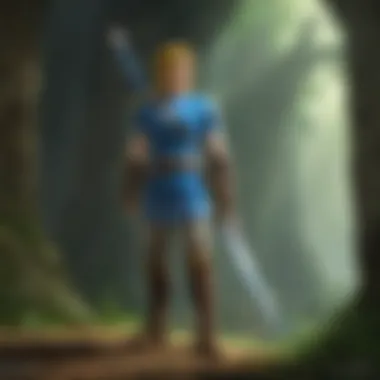

- Divergent Solutions
Many puzzles in the game can be approached in different ways. This opens up a layer of creativity, allowing players to experiment and discover solutions through exploration. It's not just about brute force; rather, the game rewards careful observation and ingenuity. - Integrated Lore
Often, puzzles link directly to the lore of Hyrule. Understanding the context can give hints to solving them, which encourages players to engage with the story on a deeper level. - Skill Progression
As players progress, the puzzles become increasingly complex, mirroring Link’s growth. This creates a sense of accomplishment when overcoming tougher challenges and deepens player investment in the game’s narrative.
"Ocarina of Time isn’t merely a game of action; it’s a mental workout that keeps players on their toes, making each step exciting with the promise of discovery."
Combat Mechanics and Enemies
Engaging in combat is integral to Ocarina of Time, where players encounter a wide variety of foes, each presenting unique challenges. The combat system itself strikes a balance between user-friendliness and depth:
- Lock-On Targeting
One of the standout features is the Z-targeting mechanic, which allows players to lock onto enemies, making combat more strategic. This system helps players focus during frenetic battles, especially against multiple enemies. - Enemy Diversity
The game boasts a rich array of enemies, each requiring different tactics. For instance, defeating a Moblin is vastly different from dealing with a Wizzrobe, whose magic attacks can turn the tide of battle. - Boss Encounters
Each dungeon culminates in a unique battle against a boss, challenging players to employ everything they’ve learned. These encounters not only test combat skills but also often tie back to earlier puzzles or story elements, providing a satisfying conclusion.
Overall, the combination of exploration, puzzle-solving, and combat mechanics all work in harmony to create an unparalleled gaming experience. Engaging with these elements not only enhances the narrative but also cements Ocarina of Time as a cultural touchstone in the gaming world.
Characters and Development
The depth of Characters and Development in The Legend of Zelda: Ocarina of Time is not just a feature of the game, but a vital element that contributes to its enduring legacy. Developing characters adds layers to storytelling which elevate the entire gaming experience. Players connect with heroes, villains, and mentors alike, making the game resonate deeply. Furthermore, character evolution mirrors the player's journey—through trials and tribulations, individuals grow and evolve, much like Link and Zelda throughout their adventures.
Link: The Protagonist's Journey
At the core of any narrative, the protagonist often shapes the story's journey, and in Ocarina of Time, Link stands as a paragon of heroism. Embarking from humble beginnings as a child in Kokiri Forest, Link represents the spirit of growth and courage. Facing obstacles, he transitions from a naive boy to a seasoned warrior. His journey encompasses themes of responsibility, loss, and sacrifice, providing players with a profound connection as they navigate perilous landscapes alongside him.
Moreover, Link's silence—his lack of spoken words—serves as a clever device, allowing players to project themselves onto his character. This silence is more than a choice; it invites players to fill in the gaps, further embroiling them in his unfolding tale. That quintessential moment, when he grasps the Master Sword and is propelled seven years into the future, marks a significant transformation. The child they once controlled must adapt to a darkened world, embodying resilience amid startling change. Link’s psychological growth and evolution are as compelling as the various terrains he traverses.
Zelda: The Evolving Role
Princess Zelda's character is similarly layered, evolving dynamically throughout the game. Initially perceived merely as a damsel in distress, her role extends far beyond this superficial characterization. Zelda gracefully intertwines with the narrative, showcasing strength and wisdom. Early on, her disguise as Sheik introduces an intriguing facet. This role allows her to contribute to Link's quest, demonstrating agility and resourcefulness—notably marked by strategic guidance as well as powerful spells.
The relationship between Link and Zelda grows throughout the narrative. Their fates, intertwined by destiny, reflect deeper themes about duty, friendship, and the weight of one's lineage. Ultimately, Zelda embodies a pivotal force, not just as a source of power, but as a cornerstone of hope. Her transformation from a royal figure locked away to an active participant amplifies the stakes, making the journey toward victory all the more rewarding.
Antagonists and Their Motivations
In every story, antagonists add layers of conflict, and Ocarina of Time presents foes that are remarkable for their complexity. Ganondorf serves as the primary adversary, driven by ambition and a dark desire to claim the Triforce's power. His villainy is compelling; it’s not merely to wreak havoc, but a quest for control that rings true to many narratives across cultures. In a way, Ganondorf represents the relentless pursuit of power, a theme pervasive in many stories outside gaming.
Yet, other foes, like the mysterious Bongo Bongo—a disembodied hand-like creature—add nuances that evoke terror through their sheer oddity. Each enemy has a unique backstory, further fleshing out the diverse world of Zelda. Players confront not just mindless monsters, but creatures shaped by their own fears and struggles. This complexity in villains ensures that the battles hold weight, making every confrontation a test not purely of skill, but of understanding the motivations behind them.
"The best stories leave an echo in your heart. In Ocarina of Time, both heroes and villains leave their mark in their unfolding narratives."
In summary, characters in Ocarina of Time are far more than avatars for gameplay. They embody essential themes and enrich the narrative tapestry. As Link and Zelda evolve and face the varied antagonists, each character plays a crucial part in building a rich experience that resonates, exemplifying the power of story-driven gaming.
Narrative and Themes
In the world of video games, a strong narrative often elevates the entire experience, and Ocarina of Time stands as a prime example of this. The interweaving of themes such as time, growth, and the mythical elements succinctly captures players’ imaginations. The significance lies not just in how the story unfolds, but also in its ability to resonate on personal levels. The developers at Nintendo meticulously crafted these narratives, embedding deeper meanings that challenge, inspire, and intrigue players around the globe.
In this section, we will explore the essential elements that make up the compelling narrative and thematic structure of Ocarina of Time.
Story Arc and Structure
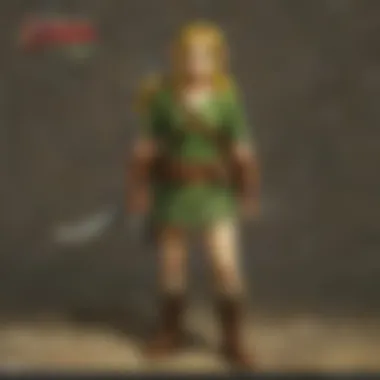

The story arc of Ocarina of Time is one of epic proportions, spanning both time and space. At its core, it follows Link’s journey from a timid boy in the Kokiri Forest to a fully-fledged hero tasked with saving the land of Hyrule. The narrative unfolds through a series of well-defined chapters, each packed with its own challenges, characters, and significant plot points.
The first major part involves Link obtaining the Ocarina of Time and using it to travel through different ages, highlighting the game's clever use of time as both a gameplay mechanic and a storytelling device. Players experience a coming-of-age story, where Link confronts various adversities and grows as both a character and a hero.
Furthermore, the integration of side quests and character interactions enriches the central storyline, drawing players deeper into the rich lore of Hyrule. Characters who may seem like mere distractions at first often reveal layers that contribute significantly to the story, showcasing Nintendo’s commitment to creating a living, breathing world.
Themes of Time and Growth
One cannot discuss Ocarina of Time without addressing the profound themes of time and growth that permeate its narrative. The game is centered around the manipulation of time, with Link's ability to travel between childhood and adulthood playing a crucial role. This is not just about solving puzzles but also about how experiences during each period shape the protagonist.
Through this mechanic, players engage with the concept of growing up. Link’s journey is fraught with challenges, and each one addresses different facets of maturity. As Link transitions from innocence to responsibility, players witness firsthand how choices impact not just the character, but also the world around him.
Ultimately, the themes of time and growth evoke a deeper contemplation. Players reflect on their own journeys, making the experience highly relatable. The ability to revisit both past and future allows for moments of reflection, creating an emotional depth that resonates long after the credits have rolled.
The Role of Myth in Ocarina of Time
Mythology pervades Ocarina of Time, truly grounding it within a larger narrative context that spans generations. The game's lore draws on various mythic motifs, including the hero's journey, the struggle between good and evil, and the notion of prophecy, enveloping the player in a timeless tale of bravery and courage.
Through artifacts like the Master Sword, the Triforce, and the various puzzles and locations across Hyrule, mythology becomes a living force within the game. Each item has a backstory influenced by larger-than-life figures, echoing familiar myths from various cultures, yet presented with a unique Nintendo twist.
This infusion of myth not only lends the game a timeless quality but also gifts players a sense of purpose—to rediscover the essence of heroism and fate. As players navigate Link’s path filled with trials and tribulations, they delve into a world where legends breathe and resonate.
"In Ocarina of Time, every challenge faced is just a chapter in a story that transcends time, making the player a part of a living myth."
Visual Art and Sound Design
Visual art and sound design are critical components that elevate the experience of gaming, especially in a title as profound as Ocarina of Time. When players embark on their adventure in the land of Hyrule, they encounter not just a game but a crafted world infused with detail and emotion. The importance of these elements lies not just in aesthetics but in how they interact with gameplay, narrative, and player immersion.
Artistic Style and Influence
The artistic style of Ocarina of Time draws on a rich tapestry of influences. Inspired by iconic fantasy art and folklore, the game combines stylized character designs with lush, imaginative landscapes. An example of this influence can be seen in the various realms – from the serene forests of Kokiri to the haunting atmosphere of the Shadow Temple. Each location is thoughtfully designed to evoke feelings that match the narrative unfolding within.
- The vibrant colors of the Kokiri Forest indicate safety and innocence.
- In contrast, the oppressive browns and deep shadows of the Shadow Temple suggest dread and uncertainty.
This dichotomy is important; it helps the player feel the weight of the journey that Link undertakes. The visual style plays a role in guiding emotions and reactions, reinforcing the storytelling without uttering a single word. It showcases that design is an intrinsic part of Ocarina of Time, creating a framework where each visual cue has significant implications for player experience.
Soundtrack and Audio Elements
The soundtrack of Ocarina of Time transcends mere background music; it’s a symbiotic relationship that enhances the atmosphere and narrative depth. Composed by Koji Kondo, the music varies from the soothing melodies heard while exploring the fields of Hyrule to the more ominous themes present in dungeons. Each track is designed to resonate per the contextual backdrop, which aids in immersion. The ocarina itself, a central theme of the game, allows players to interact with the sound creatively, utilizing music to effect changes in the game world. This unique mechanic not only entertains but invites players to build a connection with the protagonist.
The audio elements contribute significantly to the storytelling aspect—your surroundings come alive through sound:
- The distant howl of wolves hinting at danger.
- The cheerful chirping of birds signaling safe ground.


These sounds, while subtle, deepen the player's engagement, making the environment feel alive and reacting to the player's actions. In this way, the blend of art and sound fosters a uniquely immersive experience, one that continues to resonate with gamers long after they’ve set down the controller.
"The emotional weight of the game is not solely in its story but is found within the harmonies and the colors that create its world."
To appreciate Ocarina of Time fully, one must understand the intricate dance between its artistic design and sound elements. Together, they create a timeless experience that feels as fresh and inviting today as it did upon its release.
Cultural Impact and Legacy
The legacy of The Legend of Zelda: Ocarina of Time extends far beyond its initial release in 1998. Its cultural impact has played a significant role in shaping not only the franchise itself but also the broader landscape of video gaming. As one of the most critically acclaimed games of its time, it set standards that contemporary titles often aspire to meet. This section delves into the game's reception, influence on future projects, and its ongoing relevance in today's gaming environment.
Reception and Critical Acclaim
Upon its debut, Ocarina of Time quickly garnered a multitude of accolades, earning perfect scores from various publications, which was a rarity at that time. Many critics praised its groundbreaking 3D graphics, immersive gameplay, and emotional storytelling. For example, the game was awarded a score of 40/40 by Famitsu, a notable Japanese gaming magazine.
This reception was not just in the realm of gaming journalists; fans were equally enamored. The Zelda series has always had a dedicated following, but Ocarina of Time catapulted it into the spotlight, filling online forums and conventions with enthusiastic discussions and analyses. The game’s acclaim was not merely fleeting; it established a benchmark that influenced game development for years to come.
"It's a mark of true greatness when a game manages to redefine an entire genre," remarked a fan on Reddit, echoing the sentiments of many who experienced Link's adventures firsthand.
Influence on Future Titles
The mechanics introduced in Ocarina of Time laid the groundwork for countless action-adventure games that followed. Elements such as lock-on targeting, fluid combat systems, and an engaging narrative have become staples in the industry. Other franchises, like Dark Souls and Shadow of the Colossus, have drawn inspiration from its innovative design.
Further, game developers began to view storytelling as a vital component of gameplay. Before Ocarina of Time, narrative often played second fiddle to mechanics, but this title illustrated how intertwined they could be. New games began to prioritize emotional depth, pushing the envelope of interactive storytelling. Even The Last of Us owes a slice of its success to the narrative techniques pioneered by Zelda.
Continued Relevance in Modern Gaming
Fast forward to today, and Ocarina of Time remains a relevant figure in discussions about game design and narrative. It has seen various remakes and re-releases on newer consoles, ensuring that it reaches new audiences while rekindling the nostalgia of older players. The mechanics, characters, and themes continue to resonate in both indie projects and blockbuster titles.
Affection for the game can be found on platforms like social media, where fans celebrate its anniversaries through artwork and music remixes. Even online streaming platforms like Twitch see numerous players diving into the world of Hyrule, drawing in viewers who want to relive or experience the adventure for the first time.
In sum, The Legend of Zelda: Ocarina of Time is more than just a game; it's a cornerstone of gaming culture that continues to inspire and engage even decades after its release.
Playing Ocarina of Time Today
The enduring appeal of The Legend of Zelda: Ocarina of Time transcends its original release date. Today, the game is more than just a relic of the past; it's a vessel through which players experience nostalgic adventures while also delving into gameplay mechanics that have shaped modern video gaming. Understanding what makes playing this title today so significant is crucial for both new players and seasoned fans.
Modern Accessibility
In an age dominated by digital distribution and retro gaming trends, Ocarina of Time has found new life across multiple platforms. Whether it’s the classic Nintendo 64 for purists or newer consoles like the Nintendo Switch, the game is easier to access than ever. Through services like the Nintendo eShop, players can grab this iconic title with just a few clicks. More so, emulators and GameCube's Zelda: Collector's Edition have allowed older gamers to relive their cherished memories.
- Virtual Console:
Available on platforms such as the Wii and later, the game's accessibility has broadened its reach. Players craving for the authentic N64 experience can relive every moment of tension with the original graphics and sound. - HD Remasters:
Innovations like The Legend of Zelda: Ocarina of Time 3D for the Nintendo 3DS added new layers to the original game. With improved graphics and gameplay enhancements, it speaks to a new generation while remaining true to its roots.
Community and Fan Engagement
The Zelda community is stalwart in keeping the spirit of Ocarina of Time alive. With forums buzzing and social media platforms filled with fan art, lore discussions, and gameplay tips, engagement only seems to grow. Platforms like Reddit and various Discord servers have become essential hubs for fans. Here, they share theories, personal experiences, and their favorite moments from the game.
"Playing Ocarina of Time today is like meeting an old friend who has grown but still carries the charm you fell in love with years ago."
- Fan Art and Cosplay:
The artistic contribution of fans helps emphasize the narrative’s rich lore. These creative expressions bring characters and scenarios to life, attracting wider audiences to the franchise. - Speedruns and Challenges:
The gaming community has taken to speedrunning, pushing the limits of what players can achieve in Ocarina of Time. These events allow for the blending of competitive spirit with a love for the game and keep the conversation around its mechanics vibrant.
This newfound engagement ensures that Ocarina of Time continues to flourish as a cultural phenomenon. For many, it isn't just about nostalgia; it’s about coming together, sharing experiences, and connecting through time. The game remains a cherished piece of gaming history, and its accessibility today helps reinforce its legacy in the modern age.
